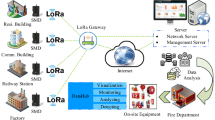Abstract
This paper presents a new strategy for fraud detection in Advanced Metering Infrastructure (AMI) based on the analysis of disturbances in the pattern consumption of end-customers. The proposed strategy is based on the use of SVM (Supported Vector Machine). SVM requires labeled training data in order to define a classification function. The need of labeled data is a serious limitation for practical implementation of fraud detection systems in AMI. To work around this problem, we propose a new strategy for training SVM classifiers that requires only normal consumption patterns in the training phase. The anomalous consumption is generated by simulating attacks on the normal consumption patterns.
Access this chapter
Tax calculation will be finalised at checkout
Purchases are for personal use only
Similar content being viewed by others
References
Anas, M., Javaid, N., Mahmood, A., Raza, S.M., Qasim, U., Khan, Z.A.: Minimizing electricity theft using smart meters in AMI. In: 2012 Seventh International Conference on P2P, Parallel, Grid, Cloud and Internet Computing (3PGCIC), pp. 176–182, November 2012
Angelos, E.W.S., Saavedra, O.R., Cortés, O.A.C., de Souza, A.N.: Detection and identification of abnormalities in customer consumptions in power distribution systems. IEEE Trans. Power Deliv. 26(4), 2436–2442 (2011)
Cortes, C., Vapnik, V.: Support-vector networks. Mach. Learn. 20(3), 273–297 (1995)
Depuru, S.S.S.R., Wang, L., Devabhaktuni, V., Green, R.C.: High performance computing for detection of electricity theft. Int. J. Electr. Power Energy Syst. 47, 21–30 (2013)
Depuru, S.S.S.R., Wang, L., Devabhaktuni, V.: Support vector machine based data classification for detection of electricity theft. In: 2011 IEEE/PES Power Systems Conference and Exposition (PSCE), pp. 1–8, March 2011
Jiang, R., Lu, R., Wang, Y., Luo, J., Shen, C., Shen, X.S.: Energy-theft detection issues for advanced metering infrastructure in smart grid. Tsinghua Sci. Technol. 19(2), 105–120 (2014)
McLaughlin, S., Holbert, B., Fawaz, A., Berthier, R., Zonouz, S.: A multi-sensor energy theft detection framework for advanced metering infrastructures. IEEE J. Sel. Areas Commun. 31(7), 1319–1330 (2013)
Nagi, J., Yap, K.S., Tiong, S.K., Ahmed, S.K., Mohamad, M.: Nontechnical loss detection for metered customers in power utility using support vector machines. IEEE Trans. Power Deliv. 25(2), 1162–1171 (2010)
NIST. Nist framework and roadmap for smart grid interoperatibility satandards, release 3. Technical report, U.S. Department of Commerce (2014)
Department of Industry and Science. Sample household electricity time of use data, July 2014
Salinas, S., Li, M., Li, P.: Privacy-preserving energy theft detection in smart grids. In: 2012 9th Annual IEEE Communications Society Conference on Sensor, Mesh and Ad Hoc Communications and Networks (SECON), pp. 605–613, June 2012
Skopik, F., Ma, Z.: Attack vectors to metering data in smart grids under security constraints. In: 2012 IEEE 36th Annual Computer Software and Applications Conference Workshops (COMPSACW), pp. 134–139, July 2012
World Bank. Reducing technical and non-technical losses in the power sector. World Bank Group, Washington, DC (2009)
Xiao, Z., Xiao, Y., Du, D.H.: Exploring malicious meter inspection in neighborhood area smart grids. IEEE Trans. Smart Grid 4(1), 214–226 (2013)
Xiao, Z., Xiao, Y., Du, D.H.-C.: Building accountable smart grids in neighborhood area networks. In: 2011 IEEE Global Telecommunications Conference (GLOBECOM 2011), pp. 1–5, December 2011
Xiao, Z., Xiao, Y., Du, D.H.-C.: Non-repudiation in neighborhood area networks for smart grid. IEEE Commun. Mag. 51(1), 18–26 (2013)
Author information
Authors and Affiliations
Corresponding author
Editor information
Editors and Affiliations
Rights and permissions
Copyright information
© 2016 Springer International Publishing Switzerland
About this paper
Cite this paper
Zanetti, M., Jamhour, E., Pellenz, M., Penna, M. (2016). A New SVM-Based Fraud Detection Model for AMI. In: Skavhaug, A., Guiochet, J., Bitsch, F. (eds) Computer Safety, Reliability, and Security. SAFECOMP 2016. Lecture Notes in Computer Science(), vol 9922. Springer, Cham. https://doi.org/10.1007/978-3-319-45477-1_18
Download citation
DOI: https://doi.org/10.1007/978-3-319-45477-1_18
Published:
Publisher Name: Springer, Cham
Print ISBN: 978-3-319-45476-4
Online ISBN: 978-3-319-45477-1
eBook Packages: Computer ScienceComputer Science (R0)




